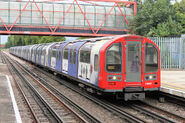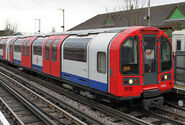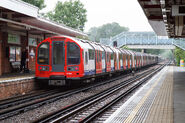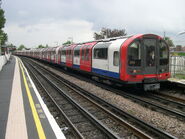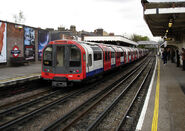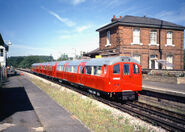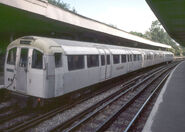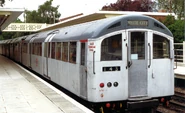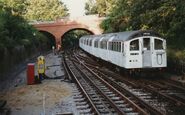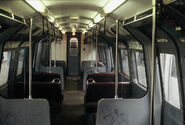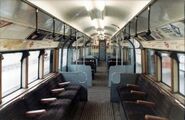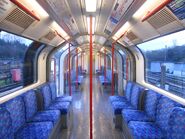London Underground Central Line is a Transport for London operated tube line in London, England. Running through central London, from Epping, Essex, in the north-east to Ealing Broadway and West Ruislip in the west, it is coloured red on the Tube map, the line serves 49 stations over 46 miles (74 km), which makes it the longest Tube line. It is also one of only two lines on the Underground network to cross the Greater London boundary, the other being the Metropolitan line. One of London's deep-level railways, Central line trains are smaller than those on British main lines.
History[]
The line was opened as the Central London Railway in 1900, crossing central London on an east–west axis, as the third deep-level Tube line to be built after electric trains made them possible. It was later extended to the western suburb of Ealing. After the Second World War, the line was expanded considerably into the recently constructed suburbs, taking over steam-hauled outer-suburban routes to the borders of London and beyond to the east. This realised plans that had been delayed by the war, when construction stopped and the unused tunnels were used as air-raid shelters and factories. However, suburban growth proved to be less than expected, and of the planned expansions one (to Denham, Buckinghamshire) was cut short due to its location in the Metropolitan Green Belt and another (to Ongar) ultimately closed in 1994 due to low patronage. The Central line has mostly been operated by automatic train operation since a major refurbishment in the 1990s, although all trains still carry drivers. Many of its stations are of historic interest, from turn-of-the-century Central London Railway buildings in west London to post-war modernist designs on the West Ruislip and Hainault branches, as well as Victorian-era Eastern Counties Railway and Great Eastern Railway buildings east of Stratford, from when the line to Epping was a rural branch line.
In terms of total passengers, the Central line is the busiest on the Underground. In 2011/12 over 260 million passenger journeys were recorded on the line. It currently operates the second-most frequent service on the network, with 34 trains per hour (tph) operating for half-an-hour in the westbound direction during the morning peak, and between 27 and 30 tph during the rest of the peak.
This makes the Central line the busiest and most intensively-used railway line in the United Kingdom: it is the only Tube line running east–west through the central core of London, running under Oxford Street and the financial centre of the City of London. Crossrail, due to begin most of its core operation in 2018 with full service by the end of 2019, will provide interchange with the Central line at Stratford, Liverpool Street, Tottenham Court Road, Bond Street and Ealing Broadway, relieving overcrowding in these areas.
Construction restarted after the war, and the western extension opened as far as Greenford in 1947 and West Ruislip in 1948. The powers to extend the line to Denham were never used due to post-war establishment of the Green Belt around London, which restricted development of land in the area. The eastern extension opened as far as Stratford in December 1946, with trains continuing without passengers to reverse in the cutting south of Leyton.
In 1947 the line opened to Leytonstone, and then Woodford and Newbury Park. Stations from Newbury Park to Woodford via Hainault and from Woodford to Loughton were served by tube trains from 1948. South of Newbury Park, the west-facing junction with the main line closed in the same year to allow expansion of Ilford carriage depot. The extension transferred to London Underground management in 1949, when Epping began to be served by Central line trains. The single line to Ongar was served by a steam autotrain operated by British Rail (BR) until 1957, when the line was electrified. BR trains accessed the line via a link from Temple Mills East to Leyton.
The Central line stations east of Stratford kept their goods service for a time, being worked from Temple Mills, with the Hainault loop stations served via Woodford. The BR line south of Newbury Park closed in 1956 and Hainault loop stations lost their goods service in 1965, the rest of the stations on the line following in 1966. Early morning passenger trains from Stratford (Liverpool Street on Sundays) ran to Epping or Loughton until 1970. The single-track section from Epping to Ongar was electrified in 1957 and then operated as a shuttle service using short tube trains. However, carrying only 100 passengers a day and losing money, the section closed in 1994, and is now used by the heritage Epping Ongar Railway.
In 1923, Standard Stock trains were introduced.
In 1949, London Transport took over the operation of the Epping to Ongar branch using existing Standard Stock trains and a steam locomotive.
In 1957, the line became electrified and steam operated services were withdrawn.
In 1960, 1960 Stock trains were introduced for the Epping-Ongar and Woodford-Hainault branches.
On 12 April 1962, 1962 Stock trains were introduced.
In 1964, the Standard Stock trains were withdrawn and the line was converted into a full 1960 and 1962 Stock operation.
In 1980, London Underground tried to close the entire Epping-Ongar line. but a reduced service was implemented instead, along with the closing of Blake Hall tube station in 1981.
In 1993, brand new 1992 Stock trains were introduced.
On 30 September 1994, the Epping-Ongar branch closed down to be converted into a heritage railway and one 1960 Stock unit was converted into a track recording train.
On 17 February 1995, the 1962 stock trains were withdrawn and the line was converted into a full 1992 Stock operation.
In 2003, The Central line was shut between January and March, after 32 passengers were injured when a train derailed at Chancery Lane due to a traction motor falling on to the track. The line was not fully reopened until June. In 2003, the infrastructure of the Central line was partly privatised in a public–private partnership, managed by the Metronet consortium. Metronet went into administration in 2007, and Transport for London took over its responsibilities.
Current Route[]
The Central Line operates via these primary locations.
Epping branch
- Epping
- Theydon Bois
- Debden
- Loughton
- Buckhurst Hill
- Woodford
- South Woodford
- Snaresbrook
Woodford via Newbury Park branch
- Woodford
- Roding Valley
- Chigwell
- Grange Hill
- Hainault
- Fairlop
- Barkingside
- Newbury Park
- Gants Hill
- Redbridge
- Wanstead
- Leytonstone
- Leyton
- Stratford
- Mile End
- Bethnal Green
- Liverpool Street
- Bank
- St Pauls
- Chancery Lane
- Holborn
- Tottenham Court Road
- Oxford Circus
- Bond Street
- Marble Arch
- Lancaster Gate
- Queensway
- Notting Hill Gate
- Holland Park
- Shepherds Bush
- White City
- East Acton
- North Acton
Ealing Broadway branch
- West Acton
- Ealing Broadway
West Ruislip branch
- Hanger Lane
- Perivale
- Greenford
- Northolt
- South Ruislip
- Ruislip Gardens
- West Ruislip


